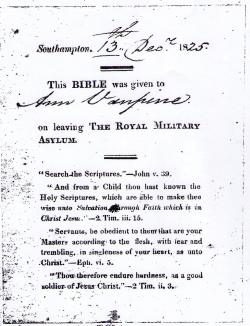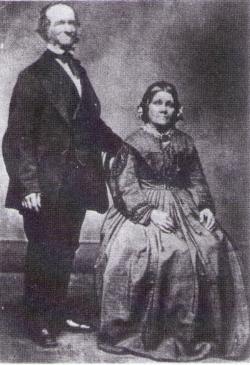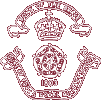Ann Maria Caroline Vanpine (misspelled Vanpain in the admission register) was, at age ten, admitted to the Southampton Branch of the RMA on 5 December 1921 and left at age fourteen on 1 December 1825 to become a cotton spinning apprentice for Samuel Oldknow (see cotton apprentices). Ann's father, Corporal John Vanpine of the 60th Foot (The Royal American Regiment), was deceased at the time of her admission. Her mother is registered as still living at the time of Ann's admission.
The family name Vanpine could have originated from a German ancestry because, following the defeat of General Braddock in 1755, the Crown authorized the raising of four battalions for service in North America. Recruits were drawn from Germany, German and Swiss settlers in Pennsylvania, Maryland and Virginia. Once established, regiments tended to draw recruits from the same sources as those serving those regiments. There is a therefore a very good chance that John Vanpine had roots in Germany or the settlements in North America.
Anne is the earliest known girl in the RMA of whom we have a photographic image, thanks to the work of her g-g-granddaughter Helen Roberts and a relative, Joyce Winfield, who have been researching their family tree. The connection of Ann with the RMA is an important one, for her history provides evidence that the lives of cotton apprentices were not entirely miserable, wretched and unhappy (see cotton apprentices).
First, it is possible to speculate on Ann's mother who was thought by her descendants to have been Jamaican. This is possible, but equally she might have been a native of Guada Loupe as well as of Jamaica. According to the Kitzmiller Search for the Forlorn Hope, which gives the location of British regiments from 1800 t0 1900, one battalion of the 60th Foot was in Guada Loupe from 1809 to 1814 (1810 being the year in which one calculates Ann was conceived); another battalion was in Jamaica.
If Ann's mother was of Caribbean-African heritage, it is more like than not that Ann was born a 'daughter of the regiment'. Regiments shipped to overseas were permitted to take with them six families per company. It sometimes happened that children born 'on station', but not 'on strength' of the regiment were bona fide children of the regiment. Ann's parents were, however, legally married or their daughter would not have been admitted to the RMA. The Institution's constitution denied access to all children born out of wedlock.
|
Before Ann left Southampton for the Samuel Oldknow's cotton mill at Mellor, Derbyshire. she was presented with a bible. [Every child, boy and girl, leaving the Asylum at Chelsea and Southampton, were given bibles with dedication pages similar the one shown here. This one contained a number of quotations appropriate to the moral education of recipient. Among them is to be found:
Servants, be obedient to them that are your Masters according to the flesh, with fear and trembling, in singleness of your heart, as unto Christ. - Eph. vi.5. Amen!
What happened to Ann during her apprenticeship as a cotton spinner is not known. The next thread in her life begins 23 March 1834 when, at age 23, she married Henry Roe Wigley in the Parish of Mottram in Longdale, Cheshire.
Each mill owner acted in loco parentis, which meant that his permission was required for apprentices to marry. By 1834, Ann would have been well out of her apprenticeship,
|
 |
|
|
 |
|
|
so the permission of her employer, Samuel Oldknow might not have been required. A note in the RMA apprentice ledger states that the apprenticeship would last until the apprentice reached his or her 21st birthday. For some, as in the case of Ann Vanpine, this would be seven years. Others sent to the cotton mills between the ages of 10 to 14 would in effect be apprenticed for up to 4 years longer, which would be hugely beneficial to their employers who paid apprentices a pittance.
Although Henry Wigley was born in Ashbourne, Derbyshire, his family moved to the village of Marple, probably for the prospect of work. Henry was employed in Oldknow's Marple Mill, which is where he presumably met Ann. This doesn't jibe with the fact that she began her apprenticeship at the Oldknow mill in Mellor. She could, however, have been moved from Mellor to Marple.
They lived in Marple long enough to have two children (one of whom, a girl, died at age 11). Henry Wigley was then promoted to foreman in the Mellor Mill to which the young family moved. There, they were accommodated in one of the row houses (No. 7 on Red Row, still standing) built by Mill Owner Oldknow for his employees. In this respect, Samuel Oldknow was an unusually benevolent employer as compared with fellow employers in the cotton industry. (See indentured apprentices.)
|
 |
Interestingly, Henry and Ann Wigley lived in No. 7 Red Row, Mellor for the rest of their days, even though, in 1851, they opened a school, probably with Samuel Oldknow's approval if not material assistance. Although the Oldknow connection is speculative, they were living in a house specifically built for mill employees. Oldknow would therefore have known of the school opening by two of his former employees.
The day and evening school opened by the Wigleys on Monday 30 June 1851 was under the auspices of the Wesleyan Methodist Association of Mellow. Ann Wigley had been taught reading, writing and arithmetic at the Southampton Branch of the RMA. which might well have been the foundation of her knowledge of academic subjects and her interest in teaching. Throughout its history, the Asylum and its successor institution, the Duke of York's, has taught those in its care to think for, and teach, themselves, to go on to higher learning. This is as true for those who passed through the Asylum as for those today who go on to take a university education. From where Henry Wigley acquired an education is not known. He could have been coached by Ann. In any case, they were remarkably well sui-
|
|
In this remarkable photograph of Henry and Ann Wigley (c1855), Ann is in
typical Victorian dress. She has gentle features, black hair and a dark complexion.
|
ted to one another because the school they began in 1851 was a successful enterprise until Henry Wigley retired.
The school hours were from 9 a.m. to 12 noon, 1 p.m. to 5 p.m. and, in the evening from 7 p.m. Monday to Friday. No hour of closing evening classes was stated. Also, the school
|
closed every Thursday at 3 p.m. In all, the Wigleys set a heavy schedule for themselves. Nor was the range of subjects taught restricted to reading, writing and arithmetic. The curriculum included reading, writing, grammar and arithmetic with elementary readings in the arts and sciences such as geography, astronomy, natural history, mechanics, natural philosophy.
Terms of tuition were:
Reading, 3d;
Reading and writing, 4½d;
Reading, writing, grammar and arithmetic,
6d.
Grammar scholars paid 1s. 6d. per quarter extra.
All scholars were required to provide their own books, stationary, &c.
Henry died in 1883 and Ann in 1890, age 83. She was sufficiently well-regarded in the community to be remembered in the local press as '…another 'prentice gone' with words that testified to her missed presence. She was buried alongside her husband Henry, her daughter Emily (who died at age 11) and her son John and his wife Margaret. On her gravestone her name is written Maria CAROLINE, which leads her g-g-granddaughter Helen Roberts, who generously contributed material for this article, to believe her g-g-grandmother preferred the name CAROLINE over ANN.
|
|
|
 |
 |
|





